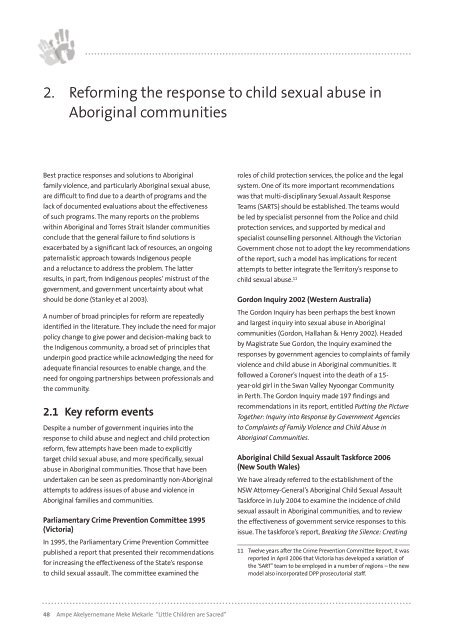bipacsa_final_report
bipacsa_final_report
bipacsa_final_report
You also want an ePaper? Increase the reach of your titles
YUMPU automatically turns print PDFs into web optimized ePapers that Google loves.
2. Reforming the response to child sexual abuse in<br />
Aboriginal communities<br />
Best practice responses and solutions to Aboriginal<br />
family violence, and particularly Aboriginal sexual abuse,<br />
are difficult to find due to a dearth of programs and the<br />
lack of documented evaluations about the effectiveness<br />
of such programs. The many <strong>report</strong>s on the problems<br />
within Aboriginal and Torres Strait Islander communities<br />
conclude that the general failure to find solutions is<br />
exacerbated by a significant lack of resources, an ongoing<br />
paternalistic approach towards Indigenous people<br />
and a reluctance to address the problem. The latter<br />
results, in part, from Indigenous peoples‘ mistrust of the<br />
government, and government uncertainty about what<br />
should be done (Stanley et al 2003).<br />
A number of broad principles for reform are repeatedly<br />
identified in the literature. They include the need for major<br />
policy change to give power and decision-making back to<br />
the Indigenous community, a broad set of principles that<br />
underpin good practice while acknowledging the need for<br />
adequate financial resources to enable change, and the<br />
need for ongoing partnerships between professionals and<br />
the community.<br />
2.1 Key reform events<br />
Despite a number of government inquiries into the<br />
response to child abuse and neglect and child protection<br />
reform, few attempts have been made to explicitly<br />
target child sexual abuse, and more specifically, sexual<br />
abuse in Aboriginal communities. Those that have been<br />
undertaken can be seen as predominantly non-Aboriginal<br />
attempts to address issues of abuse and violence in<br />
Aboriginal families and communities.<br />
Parliamentary Crime Prevention Committee 1995<br />
(Victoria)<br />
In 1995, the Parliamentary Crime Prevention Committee<br />
published a <strong>report</strong> that presented their recommendations<br />
for increasing the effectiveness of the State’s response<br />
to child sexual assault. The committee examined the<br />
Ampe Akelyernemane Meke Mekarle “Little Children are Sacred”<br />
roles of child protection services, the police and the legal<br />
system. One of its more important recommendations<br />
was that multi-disciplinary Sexual Assault Response<br />
Teams (SARTS) should be established. The teams would<br />
be led by specialist personnel from the Police and child<br />
protection services, and supported by medical and<br />
specialist counselling personnel. Although the Victorian<br />
Government chose not to adopt the key recommendations<br />
of the <strong>report</strong>, such a model has implications for recent<br />
attempts to better integrate the Territory’s response to<br />
child sexual abuse. 11<br />
Gordon Inquiry 2002 (Western Australia)<br />
The Gordon Inquiry has been perhaps the best known<br />
and largest inquiry into sexual abuse in Aboriginal<br />
communities (Gordon, Hallahan & Henry 2002). Headed<br />
by Magistrate Sue Gordon, the Inquiry examined the<br />
responses by government agencies to complaints of family<br />
violence and child abuse in Aboriginal communities. It<br />
followed a Coroner’s Inquest into the death of a 15-<br />
year-old girl in the Swan Valley Nyoongar Community<br />
in Perth. The Gordon Inquiry made 197 findings and<br />
recommendations in its <strong>report</strong>, entitled Putting the Picture<br />
Together: Inquiry into Response by Government Agencies<br />
to Complaints of Family Violence and Child Abuse in<br />
Aboriginal Communities.<br />
Aboriginal Child Sexual Assault Taskforce 2006<br />
(New South Wales)<br />
We have already referred to the establishment of the<br />
NSW Attorney-General’s Aboriginal Child Sexual Assault<br />
Taskforce in July 2004 to examine the incidence of child<br />
sexual assault in Aboriginal communities, and to review<br />
the effectiveness of government service responses to this<br />
issue. The taskforce’s <strong>report</strong>, Breaking the Silence: Creating<br />
11 Twelve years after the Crime Prevention Committee Report, it was<br />
<strong>report</strong>ed in April 2006 that Victoria has developed a variation of<br />
the ‘SART” team to be employed in a number of regions – the new<br />
model also incorporated DPP prosecutorial staff.


